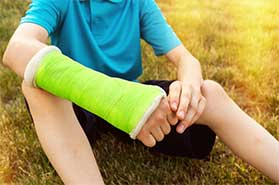Broken Bone Treatment in Fresno, TX

There are 206 bones in an adult's body, all of which can be injured. The symptoms can be severe or mild depending on the size of the break and the area it occurred. Regardless of the intensity of your pain, if you think that you have broken a bone, get help immediately. For further aid, please call (281) 481-2649 or contact Dr. David Vanderweide online.
Common Areas Where Breaks Occur
Here are some of the most common areas that breaks occur:
- Leg: There are primary main bones in the leg that can be broken. These include the shin bone (tibia), the calf bone (fibula), and the thigh bone (femur).
- Arm: There are three primary bones in the arm that can be broken. These include two bones in the forearm (radius and ulna) and the bone between the shoulder and elbow (humerus).
- Wrist: In addition to the tips of the forearm (radius and ulna) that meet up in the wrist, there is a collection of eight bones that allow the hand to perform delicate movements (trapezoid, capitate, trapezium, hamate, scaphoid, pisiform, triquetrum, lunate).
- Ankle: The shin bone (tibia), calf bone (fibula), and a third bone called the talus all meet up at the ankle joint.
- Hip: This is the most common injury for people over the age of 65, and is usually associated with osteoporosis.
Types of Fractures
There are numerous classifications for bone breaks, and determining which one has occurred will help your doctor proceed with the proper treatment plan. Here is a brief list of some common fracture types:
- Open (also known as a compound fracture): The bone has broken through the skin.
- Closed: The bone has not broken through the skin.
- Incomplete: There is a break but the bone has not separated into two parts.
- Complete: The bone has broken into two or more parts.
- Comminuted: The bone breaks into several pieces and most likely requires surgery. This is a type of complete fracture.
- Greenstick: The bone cracks, but not all the way, like when you try to break a fresh green stick. This is a common fracture in children and is categorized as an incomplete fracture.
Reasons to Seek Help After Breaking a Bone
A severe break, such as a compound fracture, may be hard to ignore, but when the injury results in milder symptoms such as tenderness, bruising, or swelling, some people may do just that. Ignoring a fracture can lead to a number of conditions that will affect you the rest of your life. Some of them include:
- Osteoarthritis, or wear and tear of the joints. This condition is much more likely to develop in a joint that did not heal properly after a break.
- Limited range of motion or diminished strength in the injured area.
- Damage to the nerves or blood vessels near the broken bone.
- Compartment syndrome which is characterized by pain, swelling or disability in the muscles near the injured bone.
If you think you may have broken a bone, or simply want to speak to a doctor about previous breaks, please call (281) 481-2649 or contact Dr. David Vanderweide online.
David G. Vanderweide MD, PA
Address
333 N Texas AveSuite 2000
Webster, TX 77598
(281) 481-2649
www.dvanderweide.com


